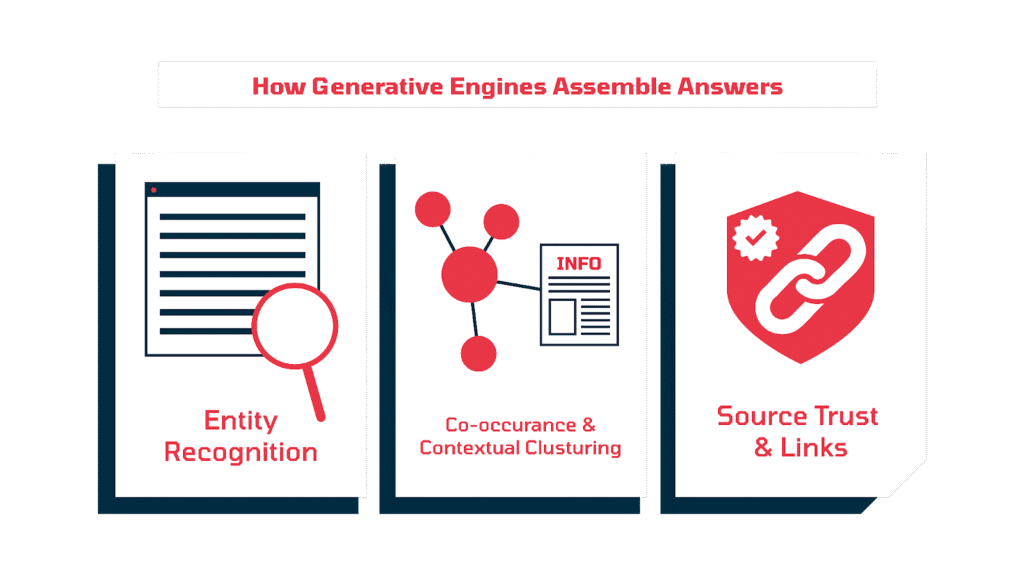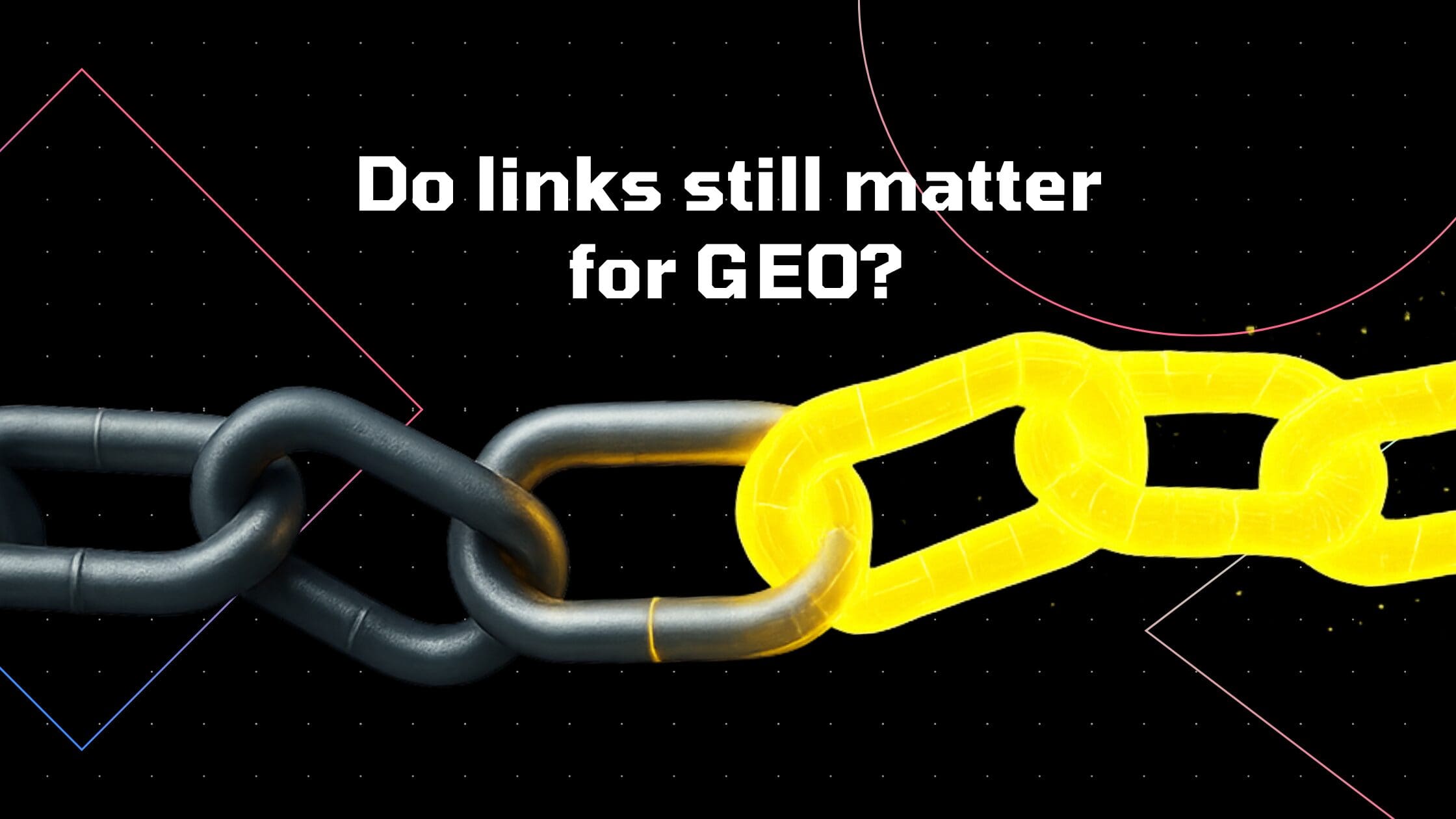Table of contents
Yes, links still matter for Generative Engine Optimization (GEO). But their role has shifted: AI engines don’t reward you for piling up hundreds of backlinks. Instead, they value links that act as trust signals, showing your brand is credible, relevant, and worth citing in real answers.
TLDR
- Backlinks matter, but AI also values brand mentions and co-occurrences.
- GEO prioritizes entity recognition and trust signals over traditional SEO keywords.
- Quality signals: trusted backlinks, repeated mentions, and contextual co-citations, drive AI citations.
How Generative Engines Assemble Answers
Unlike Search Engines, LLMs (Generative engines) don’t just crawl pages and rank them by keywords. Instead, they identify, evaluate and rate how entities appear across the web. This helps them to decide which sources are trusted, and how content is connected. These relationships that LLM crawlers make between entities form the backbone of an AI’s authority graph and determine which sources the model is likely to cite. Here is how they do it;

- Entity Recognition
The AI first needs to clearly identify each entity in a query: your brand, your competitors, and relevant product categories. So, disambiguation is critical: when the model sees your company name in a prompt, it uses the context of that prompt to understand the user is referring to you. For example, Nike is both a brand and the ancient Greek Goddess of Victory when adding the word Nike into a prompt context around the word helps AI to disambiguate the meaning. The prompt “What was the reward Nike and her siblings received for their loyalty to Zeus?”. Makes it clear who we’re talking about.
- Co-Occurrence and Contextual Clustering
Tô understand everything about your business, Generative engines track how often, and in what context, your brand appears alongside trusted concepts. For example, if your company keeps showing up with terms like “workflow automation,” “API integrations,” and “user provisioning” across reputable sources, AI starts linking your brand to these topics in its understanding.
- Source Trust and Links
This is the stage where links, mentions, and co-citations come together to influence AI perception. Unlike traditional SEO, backlinks aren’t counted individually to determine authority. Instead, they help AI map relationships between credible domains and content. Brand mentions, whether linked or not, signal relevance, while co-citations, when multiple trusted sources reference your brand together, reinforce credibility. Combined, these signals increase the likelihood that AI will cite your content in responses.
In short, Generative Engine Optimization (GEO) is about giving AI a clear, connected picture: defining your entities, broadening context, and building trusted link networks so assistants can confidently answer buyer questions with your brand front and center.
How Backlinks Help You To Rank In LLMs
Most large language models don’t crawl the web with a link graph like Google Search and don’t count backlinks individually. Instead, they track how often your brand appears across domains and the context of those mentions. In this sense, backlinks are less about direct authority and more about signaling that your brand belongs in relevant conversations.
Links still play an indirect role in shaping the ecosystem these models operate in. AI tools like Google’s AI Overviews pull content from the search index, and being recognized as a trusted source there increases the chances your content will be surfaced in AI-generated answers. Similarly, platforms like Perplexity rely on Bing’s index. So links that help you rank in traditional search engines influences SEO rankings which influence AI outputs.
What Directly Affects LLM Citations Then?
While links remain useful, they are just one piece of the puzzle. AI evaluates the full picture: who mentions your brand, the context of those mentions, and the other entities your brand appears alongside. High-quality backlinks are most effective when they complement this broader network of signals, helping to establish recognition and authority that single links alone cannot achieve.
In GEO, success comes from combining backlinks with consistent brand mentions, co-citations, and contextual relevance across multiple trusted sources. This integrated approach ensures AI systems can accurately recognize and cite your brand, positioning you as a credible and authoritative source within your category.
Backlinks vs. Brand Mentions
Backlinks and brand mentions play distinct but complementary roles in how AI perceives your company, and understanding that is essential for effective strategy. While backlinks provide authority by pointing directly to your site; mentions, help AI recognize and categorize your brand as an entity.
Mentions play a key role in how AI systems understand your brand. Being named in a reputable blog, a forum discussion, or even a social media thread helps them recognize your company as an entity and start associating it with specific categories, products, or industries. Hyperlinked mentions tend to carry more weight because they also point back to your site as the authoritative source, but unlinked mentions still add value by reinforcing brand visibility in relevant contexts.
What makes mentions powerful is not just their presence, but their setting. Mentions in trusted publications signal credibility, while mentions in active communities (like Reddit threads or Quora) indicate relevance and engagement. AI is constantly scanning for these signals, weighing how and where your brand shows up in the broader digital conversation.
Context is another critical factor. If your brand is repeatedly mentioned alongside industry terms, competitor names, or key thought leaders, AI begins to map those relationships. Over time, this co-occurrence builds a stronger semantic link between your brand and the topics that matter most in your space. Think of it as giving AI “clues” about where your brand belongs in the knowledge graph it’s building.
The result is that both backlinks and brand mentions, working together, expand your digital footprint. Backlinks provide authority, while mentions (linked or not) provide reinforcement and breadth. When they overlap across multiple credible sources, you’re no longer just another company on the web, you’re positioned as a recognized entity worth citing when AI delivers answers in your category.
Balancing Backlinks, Mentions and Co-Citations in Your GEO Strategy
Backlinks and brand mentions both matter, but they don’t carry the same weight, or require the same level of effort. A smart GEO strategy means knowing what to tackle first and what to treat as reinforcement. The goal here is to prioritize the highest-impact signals first:
- Start with authoritative backlinks, the kind that come from respected industry outlets, analysts, or well-known blogs. These act as foundational signals that AI systems trust. They also boost your brand in SEO results which as we have mentioned, is foundational to being cited in LLMs.
- Once you’ve secured a few of those anchors, expand your efforts toward consistent brand mentions, especially in niche communities where your audience spends time. Even without hyperlinks, those mentions reinforce credibility and help AI connect your brand to the right conversations.
- Finally, consider co-citations. When your brand appears alongside relevant industry keywords, peers, or competitors, AI gains contextual signals that help place your company within its category. For SaaS companies, this happens when:
- You are mentioned alongside competitors in “best-of” or category comparison guides. For example, our “Top GEO Agencies” article lists Singularity Digital alongside other well known agencies and reinforces our placement within that category.
- You are featured in case studies or user stories that reference related technologies or solutions. Example: A customer story that discusses integrating your API with Salesforce or Slack positions your brand within the broader workflow and automation space.
- Your brand appears in discussions within niche communities, such as Reddit, Stack Overflow, or Quora. For example, when your product is mentioned alongside related tools or solutions in these conversations
The key takeaway: invest first in quality backlinks, then layer in mentions and contextual co-citations. That balance builds a footprint in AI systems, without wasting time or budget chasing hundreds of links.
Practical Steps to Build AI-Trusted Links and Mentions
Theory only gets you so far. To actually earn the kinds of backlinks and brand mentions that AI trusts, you need to create the right conditions for them to happen. Here’s a clear roadmap to make your efforts tangible and effective.
1. Optimize your internal linking structure: Start by organizing your own site for clarity and discoverability. Create hub pages around your most critical topics, pricing tiers, feature deep dives, integration overviews, and interlink them using consistent, brand-focused anchor text. Keep each page focused on a single idea, break content into scannable headings and concise paragraphs, and sprinkle in schema markup. This makes it easier for AI to parse your content and understand your product hierarchy.
2. Create content that attracts citations: Produce original reports, deep-dive guides, or comparison pages that naturally encourage external mentions. High-value, unique content is far more likely to be referenced by industry blogs, analyst reports, or even competitors creating related content, directly supporting the goal of building AI-trusted links and mentions.
3. Secure strategic brand mentions: Identify reputable industry blogs, newsletters, and online communities where your audience engages. Submit guest articles, provide expert quotes, or share detailed examples in discussions. Participate in relevant groups and forums by sharing real user stories or practical examples in your answers to make mentions more authentic and context-rich.
4. Earn high-context external links: Coordinate data-driven PR campaigns or promote original research through reputable outlets like TechCrunch or Product Hunt. Target placements that highlight your core services or solve pressing industry problems. Whenever possible, negotiate branded anchor text; this provides a direct signal that helps AI associate your brand with the right concepts.
5. Layer co-occurrence and contextual signals: Look beyond individual backlinks or mentions. Ensure your brand consistently appears alongside key industry terms, relevant competitors, or trusted sources. When AI scans content across the web, it detects these repeated associations and begins mapping your brand to those topics within its knowledge graph. For example, if multiple blogs, case studies, or forum discussions reference your SaaS in the context of “workflow automation,” “API integrations,” and “enterprise security,” AI learns to recognize your brand as a trusted entity in that category. Over time, these repeated co-occurrences strengthen your authority and increase the likelihood that AI will cite your content accurately.
Measuring Impact
Building links and mentions for AI visibility only matters if you can prove they’re moving the needle. The challenge is that unlike traditional SEO, where rankings and traffic are clear signals, AI-driven visibility doesn’t have a single dashboard you can check. Instead, you have to piece together indicators that show whether your brand is becoming more “AI-ready.”
Start by monitoring how often your brand is cited, or even just named, in industry conversations. Tools like Mention, Brand24, or Google Alerts can help track unlinked mentions, while Ahrefs or Semrush cover backlinks. This gives you a baseline view of how visible your brand is becoming across trusted sources.
Next, track shifts in co-occurrence by analyzing how often your brand appears alongside target keywords, competitors, or industry topics. Use tools like BuzzSumo and SEMrush Topic Research to identify articles and posts where these co-mentions occur. For deeper insights, NLP platforms such as MeaningCloud can reveal patterns in how entities and terms are associated with your brand across content. Over time, increasing frequency of relevant co-occurrences signals that AI is mapping your brand to those categories and concepts, making it more likely to cite your content accurately.
Finally, evaluate your progress by monitoring how often your brand appears in AI-generated answers to questions your customers would ask. Platforms like Crayon, or GrowthBar can help track mentions systematically, showing whether your brand is surfacing more frequently than competitors. Rising visibility in these outputs over time indicates that your strategy of links, mentions, and contextual co-occurrences is working.
Bottom Line
Backlinks still matter, but they’re no longer the whole story. In the world of generative AI, links work best as part of a bigger picture that includes brand mentions, co-citations, and the context in which your company shows up online.
Think of it this way: a backlink from a trusted source is like a formal introduction, but consistent mentions in reputable places are what turn that introduction into recognition. Over time, AI systems learn who you are, what you do, and how you connect to the broader conversation in your industry.
That’s why the smartest approach isn’t chasing as many links as possible, but building a balanced, quality-driven strategy. Prioritize trusted sources, cultivate meaningful mentions, and make sure your brand is consistently tied to the topics and categories you want to own.
If you do that, you’re earning trust in the eyes of both search engines and AI systems. And in the long run, that trust is what gets your brand cited, surfaced, and recommended when it matters most.



